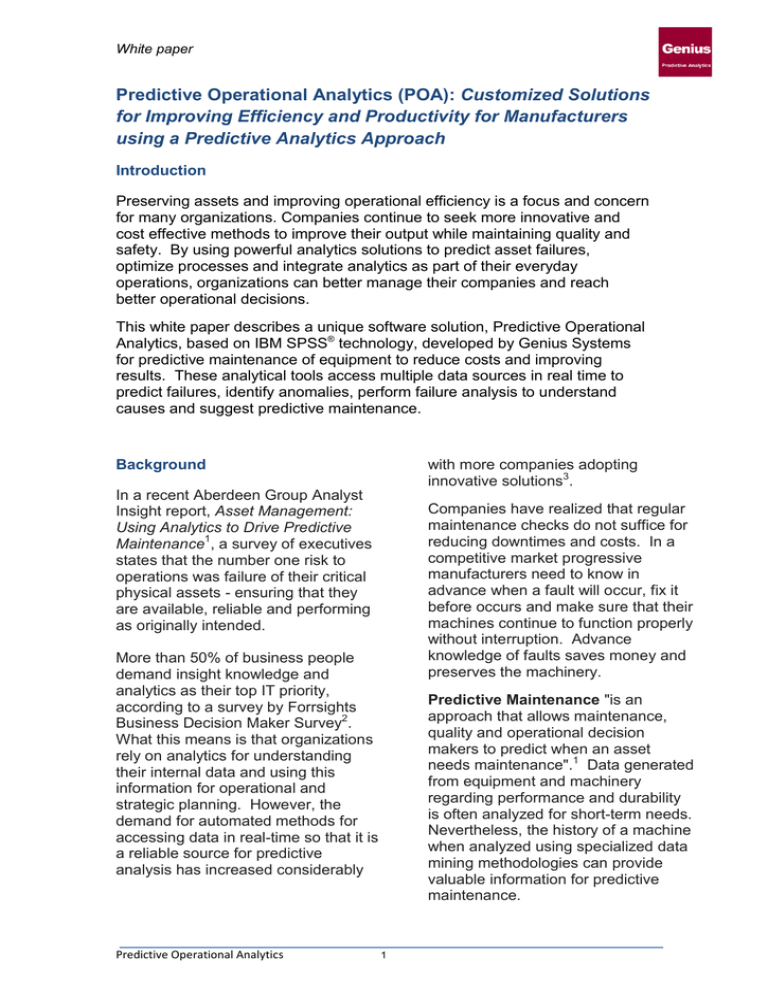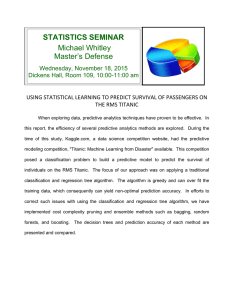Predictive Operational Analytics (POA): Customized Solutions for
advertisement

White paper Predictive Operational Analytics (POA): Customized Solutions for Improving Efficiency and Productivity for Manufacturers using a Predictive Analytics Approach Introduction Preserving assets and improving operational efficiency is a focus and concern for many organizations. Companies continue to seek more innovative and cost effective methods to improve their output while maintaining quality and safety. By using powerful analytics solutions to predict asset failures, optimize processes and integrate analytics as part of their everyday operations, organizations can better manage their companies and reach better operational decisions. This white paper describes a unique software solution, Predictive Operational Analytics, based on IBM SPSS® technology, developed by Genius Systems for predictive maintenance of equipment to reduce costs and improving results. These analytical tools access multiple data sources in real time to predict failures, identify anomalies, perform failure analysis to understand causes and suggest predictive maintenance. with more companies adopting innovative solutions3. Background In a recent Aberdeen Group Analyst Insight report, Asset Management: Using Analytics to Drive Predictive Maintenance1, a survey of executives states that the number one risk to operations was failure of their critical physical assets - ensuring that they are available, reliable and performing as originally intended. Companies have realized that regular maintenance checks do not suffice for reducing downtimes and costs. In a competitive market progressive manufacturers need to know in advance when a fault will occur, fix it before occurs and make sure that their machines continue to function properly without interruption. Advance knowledge of faults saves money and preserves the machinery. More than 50% of business people demand insight knowledge and analytics as their top IT priority, according to a survey by Forrsights Business Decision Maker Survey2. What this means is that organizations rely on analytics for understanding their internal data and using this information for operational and strategic planning. However, the demand for automated methods for accessing data in real-time so that it is a reliable source for predictive analysis has increased considerably Predictive Operational Analytics Predictive Maintenance "is an approach that allows maintenance, quality and operational decision makers to predict when an asset needs maintenance".1 Data generated from equipment and machinery regarding performance and durability is often analyzed for short-term needs. Nevertheless, the history of a machine when analyzed using specialized data mining methodologies can provide valuable information for predictive maintenance. 1 White paper Studies have shown that applying analytics to production lines can improve reliability and quality while increasing performance and reducing costs. A major energy provider by implementing Predictive Maintenance solutions was able to perform scheduled proactive maintenance action with minimum costs and avoid costly repairs and revenue loss. Once the causes were displayed, alternative actions were recommended to avoid the occurrence of other problems. One suggestion, for example, was to change a part in the complex machinery or in the operating instructions to avoid the repeated failure. Another action was to perform proactive maintenance. It was also recommended to use the particular pattern as a predictor that would create an alert whenever the problem or fault occurs. Genius Systems Ltd. (an IBM business partner) specializes in providing advanced Operational Analytics for industry and production using IBM SPSS® technology. 2. Proactive Maintenance This is the output of the Root Cause Analysis as explained above. Principles of Operation Genius developed a comprehensive solution portfolio for Predictive Maintenance. This range of solutions is divided into six categories. Each category represents the common challenges and business issues that are typical in the complex manufacturing environment. To explain how Predictive Maintenance works, we will discuss solutions that Genius provided for a primary utility company. 3. Fault Detection Fault detection or prediction is the ability to predict as early as possible that a problem is going to occur and is based on the results of the Root Cause Analysis. 4. Anomaly Detection The two solutions mentioned above are based on a "supervised learning" which means learning from known historical examples of failures. 1. Failure Root Cause Analysis However, history of failures is not enough. It is reasonable to assume that there exist many hidden malfunctions that have not yet caused a concrete damage or stopped the production line. And yet it is critical for engineers to have prior knowledge of these potential failures. This is a post mortem analysis, which is performed after encountering a repeated problem, such as the collapse of a turbine, or even an assembly break down. Before using POA solution, engineers would investigate the problem, and in many cases they could not pinpoint the cause. In our approach, the application analyzed the acquired data from the unit, identified the significant pattern of behavior and tried to detect the cause of the problem. This is where the anomaly detection approach comes in. This is an "unsupervised learning" method. In this analysis, by using advanced algorithms, the normal behavior of the turbine or machine is studied so that we can predict the expected value of each of the hundreds of sensors and indicators, and to identify in advance any deviation from the normal and By using decision trees, a clear and logical explanation of the problem and the factors causing the repeated failure was shown. Predictive Operational Analytics 2 White paper expected behavior. The findings of this analysis provided critical data for the engineers to investigate the anomalies and to draw conclusions. One implementation of this method is what we call Sensor Reliability Analysis, which means to verify the integrity and reliability of each sensor. We do this by comparing the actual behavior, i.e., the frequency of the signals and the values it transmits, to the normal behavior profile of the sensor. sensor, a dedicated model which predicts the actual value at any time or state of the turbine, based on all other tags. Using these models, we are able to report in real time the cases where there is a significant deviation of the actual value from the expected one. One example of using this method is a 'Fuel Consumption monitoring' where we continuously monitor the efficiency of the turbine, the ratio between the fuel flow and the electricity produced. 6. SPC Monitoring 5. Real Time Monitoring Statistical Process Control (SPC) is an application where input from the testing machines and quality assurance labs are analyzed showing the critical KPI's and indicate warnings and alerts. After identifying the critical KPIs (Key Performance Indicators) or the most sensitive tags or parameters that affect the performance, we might want to monitor them continuously. To do so, we not only watch them on monitors but we build for each tag or Fig. 1: Flowchart showing the use of multiple technologies and methodologies The categories above incorporate a complete solution for predictive maintenance which enabled the utility company to preserve their assets and Predictive Operational Analytics reduce costs. By having advance knowledge of failures, they were able to perform preventive maintenance on 3 White paper time to avoid failures and avoid any downtimes. Predictive Operational Analytics: Statistical Process Control Predictive Operational Analytics: Root Cause Analysis Several Key Performance Indicators (KPIs) of gas turbines’ wellness are critical to the control engineer. However, these temperature and pressure KPIs tend to behave differently, according to unit status. To constantly monitor them, Genius developed a designated custom-made system - SPC (Statistical Process Control) for analysis. To illustrate the use of Root Cause Analysis, we will describe how this worked in an electric company where there were unexplained occasional collapses of gas turbines resulting in costly downtimes which affected the availability of electricity supply. Using predictive analytics technology, Genius' application identified the root causes of the collapses to prevent reoccurrence of such events in the future. Three KPIs were chosen for monitoring, and three time-resolution options were determined: 1, 15 and 60 minutes. The system was designed such that IBM-SPSS statistics continuously draws raw data from the operational database, analyses them online using the SPC technique, and produces an HTML output, which in turn is shown on web monitors. A thorough data analysis revealed differences in the homogeneous dispersion of a certain tag prior to collapses. Further analyses showed that the problem did not occur only before the crash, it occurred also several times in the past without causing a crash. The benefits of adopting this method proved that outlying KPIs are easy to detect. With a click of a button, the control engineer can choose site, unit, and work state for the SPC analyses. The HTML-based system can be shown on any platform with a web browser, including desktops, laptops, tablets and smartphones, without any software installation. As a result of our solution, the turbine configuration parameters were changed according to the findings of the analysis and the problem disappeared. The analytical tools brought significant savings, both in time of fault understanding and in dollars spent on turbine failures and downtimes. This system enables the company to remotely supervise a variety of KPIs across various units, work phases and time resolutions, in a user-friendly graphical user interface. In addition, the combined team effort of the analyst, engineer and database manager proved to be of significant value in solving the problem. Predictive Operational Analytics 4 White paper are then moved to another machine which bends the steel to different shapes before forming the final product. Predictive Maintenance Solutions for the Production Line Unscheduled stoppages in the production line due to faults or undue repairs are of utmost importance to the manufacturer. It can cause delays and unwarranted expenses in equipment and labor. Using Predictive Maintenance to analyze patterns in the production line for fault detection ultimately reduces costs and provides a known schedule for maintenance and upkeep of machinery. Predictive Analytics in this case analyzes the streaming data, and is able to detect as early as possible signs of anomaly which can lead to a break. The technicians can then do proactive maintenance which will prevent the predicted failure. Below are two examples of how the deployment of a Predictive Maintenance solution helped solve the problem of detecting faults, saving the companies both funds and resources. In both cases above, using Predictive Operational Analytics for predictive maintenance helped these organizations solve their problems and provided them with future solutions. The first example involves a paper manufacturer. The production line includes the use of large machinery and hundreds of sensors that track data. The material undergoes several stations, wet and dry areas and more. By working together with the different technical groups in these companies, learning and analyzing their work patterns, Genius was able to successfully improve their maintenance schedules and preserve the running of the machinery. A problem occurred where paper was ripped or holes were formed causing production to stop and the loss of raw material. Obviously this paper could not be used or supplied to the customer. Investing in innovative analytical tools in industry, although costly at first, resulted in improving reliability and reducing expenditures. The ROI (Return On Investment) was evident in a short time justifying the financing. Using advanced analysis, Genius was able to explain the factors causing the holes and rips. An early alert was implemented with recommended preventive action saving the manufacturer both time and money. The second example is a metals and steel factory. Big cranes lead the heavy steel cylinders (around 20 tons each) into the production lines to machines that cut the steel into small pieces of different sizes. The pieces Predictive Operational Analytics One of the factory bottlenecks is the conveyor belt that moves the steel from one station to another along the production line. Conveyor belts are based on bearings and when a bearing is broken at a critical point, the entire production line stops. 5 White paper Predictive Operational Analytics for Alarm Handling Control and monitoring systems such as SCADA (Supervisory Control and Data Acquisition) and HMI (Human Machine Interface) monitor and control industrial processes. The system monitors and detects when an alarm has occurred due to values that are outside their limits or manufacturer's or from not adhering to the set rules. 1. Sequence Analysis which identifies an explicit chain of alarm events. This is useful for decreasing the number of alarm events appearing on the operator's screen. It also provides prior understanding of an alarm event thereby instead of a number of small alarm events into a more clear indication of the cause. 2. Severity Analysis distinguishes between a normal alarm event or indicator to an extreme event. 3. Event Analysis evaluates the significance of the event according to the sequence and the messages received and inform the appropriate manager or operator. The role of the alarm indicator is to draw the operator's attention to the part of the system "in alarm" so that appropriate action can be taken. However, when there is a cascade of alarm events occurring in a short time, the underlying cause (which might not be the earliest event detected) may get lost in the noise. 4. Anomaly Detection is the detection of faulty sensors. 5. Descriptive Statistics is the quantitative description of the frequency of alarm event according to type, site, time, etc. To handle the cascade of alarm events, Genius developed an application using Predictive Operational Analysis. This application consists of the following: Fig. 2: Real-Time Deployment Predictive Operational Analytics 6 White paper Predictive Operational Analytics 7 White paper References Conclusion It has become increasingly important for management in organizations to keep updated with more advanced and reliable tools to reduce costs and preserve assets. Implementing analytical applications to help solve problems, reduce downtimes, improve quality and reliability position managers as leaders and innovators in their field. Results from recent IBM studies have found that, on aggregate, companies that use predictive maintenance solutions attain: © Genius Systems Ltd. 7 Hasivim Street, Kiryat Matalon Petah Tikva, Israel 49170 Tel: 972-3-9222204 www.genius.co.il o ten times higher ROI o a 20-25 percent reduction in maintenance costs o a 70-75 percent elimination of breakdowns o a 35-45 percent elimination in downtime o a 20-25 percent increase in production than those that use traditional approaches. 4 Genius Systems, IBM's Business Partner, delivers advanced analytical solutions and sells all IBM SPSS business analytics software products. Genius helps customers to make smarter business decisions, to meet business goals and to achieve competitive advantages, by applying sophisticated analysis techniques to enterprise data. If organizations can reduce costs caused by failures and crashes by having advanced knowledge, then they are better equipped to handle repairs and improve the production process. In addition, this is a more efficient use of labor resources. If a crash can be predicted early enough, then repairs can be made in normal working hours and not during overtime. All the above factors contribute to customer satisfaction with prompt and timely deliveries, improvement in product quality and better services. Predictive Operational Analytics 1. Asset Management: Using Analytics to Drive Predictive Maintenance. Aberdeen Group, March 19, 2013. (www.aberdeen.com/AberdeenLibrary/8 380/AI-predictive-asset-analytics.aspx). 2. Forrsights Business Decision Maker Survey, Q4 2012 3. Forrsights BI & Big Data Survey, Q4 2012 4. Maximize asset productivity and operational performance, IBM, July, 2013 Based on more than ten years of extensive experience and know-how as local representative of SPSS Inc. as the world leader in the area of Predictive Analytics, Genius Systems is a one-stop shop in the business analytics field – statistics, data-mining and business intelligence. Genius' consultant team has acquired expertise in many domains and offers professional services and comprehensive predictive analytics capabilities to help customers achieve smarter business outcomes, based on IBM SPSS products and technologies including data collection for market research and feedback management, text and data mining, advanced statistical analysis and predictive solutions. Since 2001 Genius Systems was the Israeli Distributor of SPSS Inc., at this time the leading global provider of predictive analytics software and solutions. With the acquisition of SPSS by IBM, Genius Systems became an IBM Advanced Business Partner. Genius is certified to sell and support IBM SPSS products. 8





